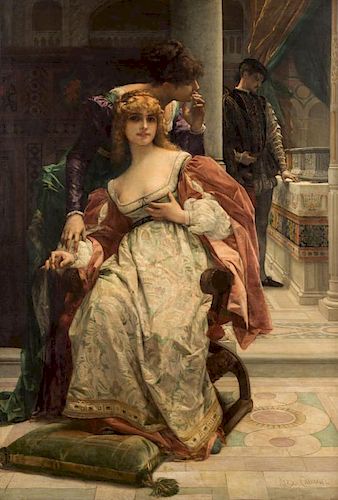ALEXANDRE CABANEL (FRENCH 1823-1889)
About Seller
566 East Boston Post Road
Mamaroneck, NY 10543
United States
Our auctions feature an impressive selection of fine art, decorative art, rare books, icons, militaria, and other objects from antiquity to the present. Shapiro Auctions advertises globally and has clients all over the world, while providing a rare combination of personal service and the ability to ...Read more
Two ways to bid:
- Leave a max absentee bid and the platform will bid on your behalf up to your maximum bid during the live auction.
- Bid live during the auction and your bids will be submitted real-time to the auctioneer.
Bid Increments
| Price | Bid Increment |
|---|---|
| $0 | $25 |
| $500 | $50 |
| $1,000 | $100 |
| $2,000 | $250 |
| $5,000 | $500 |
| $10,000 | $1,000 |
| $20,000 | $2,500 |
| $50,000 | $5,000 |
| $100,000 | $10,000 |
| $200,000 | $25,000 |
About Auction
May 21, 2016 - May 22, 2016
Shapiro Auctions info@shapiroauctions.com
- Lot Description
ALEXANDRE CABANEL (FRENCH 1823-1889)
Portia and the Caskets, Scene from the Merchant of Venice, 1886
oil on canvas
132 x 91.5 cm (52 x 36 3/8 in.)
signed and dated Alex. Cabanel 1886 lower right, old gallery label on verso
PROVENANCE
William Schaus Galleries, New York, NY before 1910
Collection of Mrs. A. Tabin, Evanston, IL
Auction of Chicago Art Galleries, Chicago, IL, 1947
Acquired by the family of the present owner at the above in 1947
LOT NOTES
One of the most distinguished European history painters of the 19th century, Alexandre Cabanel`s work displays an ever-present tension between his classical training and theatrical tendencies. Combined with the characteristic display of the Second Empire`s romantic eclecticism, the master`s virtuoso brushwork, so brilliantly presented here in Portia and the Caskets, are the quintessential academic qualities that led him to become a leading representative of the Paris Salon and Napoleon III`s preferred artist.
As a student at the prestigious Ecole des Beaux-Arts, Cabanel studied under Francois Edouard Picot, a pupil of the proponent of the French Revolution and famed Neoclassicist, Jacques-Louis David. At the Academy, students spent a significant part of their time learning potential subject matter from classical texts and literature. In reference to his time at the academy, Alexis Lemaistre wrote: “Every page of Sophocles or Homer could literally be translated into a tableau; the difficulty lie in knowing which to choose.” Despite praise garnered by The Birth of Venus, a composition presently in the permanent collection of the Musee d`Orsay, Paris (and originally acquired for the private collection of Napoleon III), it was theater that inspired Cabanel`s greatest work.
Shakespeare in particular, no doubt spurred by the Anglomania then sweeping France, was a favorite source for Cabanel. The artist turned to Othello and The Merchant of Venice on multiple occasions for inspiration. Cabanel first addressed the selection of Portia`s groom five years earlier, in a sweeping panorama of the court, showing the grand beauty of the Italian palace, with the bride relegated to the right side of the composition, surrounded by courtiers. Portia and the Caskets presents an examination of one of Shakespeare`s most compelling heroines, celebrated for actively shaping her own destiny and steadfastly pursuing her desires. Unlike in the previous iteration of this scene, there is no doubt that Portia is the focus of the composition. The artist chose to center on her luminous visage, as hope and trepidation play out in her mind and she gently touches her hand to her heart, hoping that her beloved Bassanio will choose the casket containing her picture and secure their future.
This painting by Cabanel proved to be a popular work, as seen by the proliferation of typogravures of the composition, such as the one presented among the additional images here. - Buyer's Premium



 EUR
EUR CAD
CAD AUD
AUD GBP
GBP MXN
MXN HKD
HKD CNY
CNY MYR
MYR SEK
SEK SGD
SGD CHF
CHF THB
THB


















